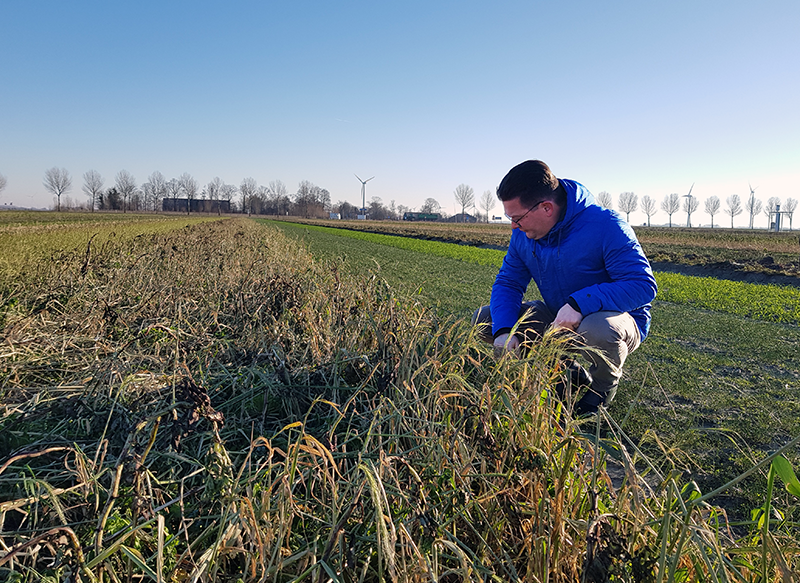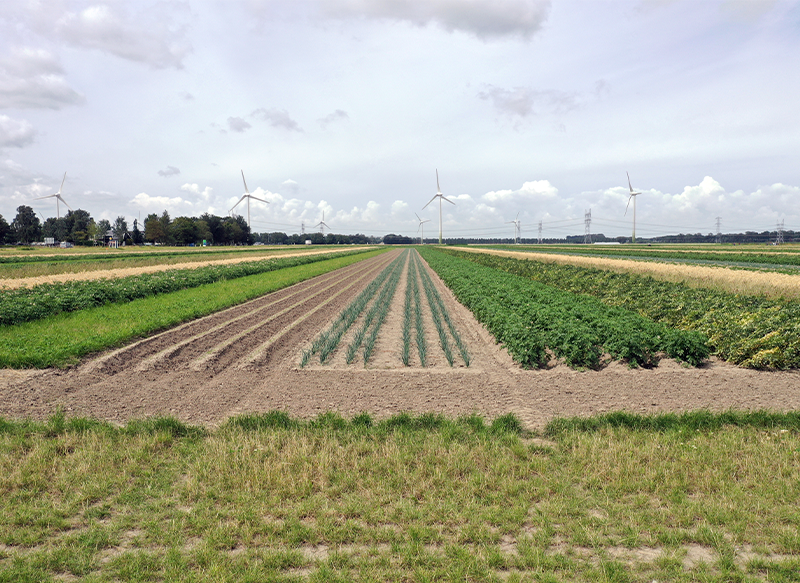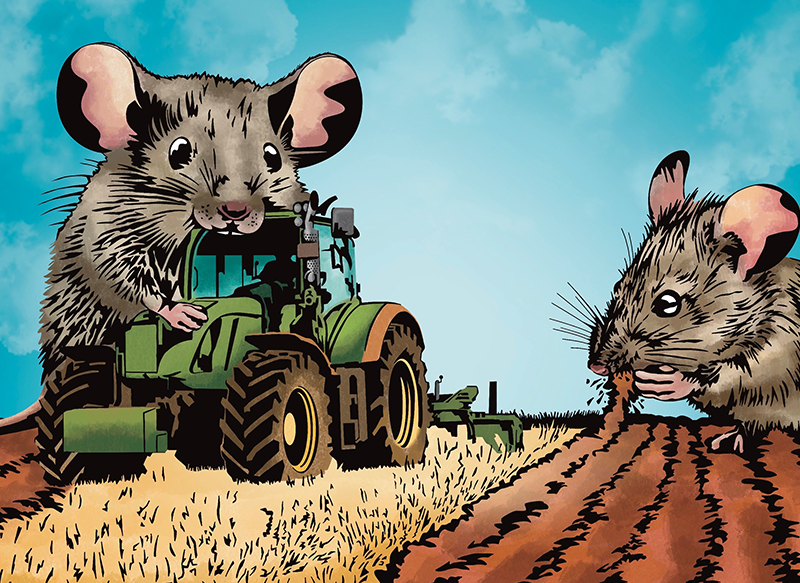Agriculture has got to be done differently in the future. The options are being tested at the Farm of the Future in Lelystad. And in the course of this year, elsewhere as well.’
There is not much to be seen in winter on the 20 hectares of farmland on the Edelhertweg road in Lelystad. Most of the crops have been harvested. As far as possible, at least, given the wet autumn we had. But the farming system does jump out at you, even on a cold winter day. This is not a standard large-scale agriculture location: crops are grown here in strips.
The Farm of the Future, that’s strip cultivation, isn’t it? Pieter de Wolf gives a little sigh. He is aware of that notion. Yes, those strips. ‘Those narrow strips dominate the image people have. The plus side of that is that we’ve put something out there that looks innovative. The downside is that for four years, we’ve been doing our best to make clear that there’s more to the Farm of the Future than growing crops in narrow strips. We’ve also got strips 16 metres wide, but photographers are always drawn to those narrow strips.’ He understands it though. ‘It is a lovely sight. Eight crops side by side in strips three metres wide. All those different colours.’
Along with his fellow project leader Wijnand Sukkel, De Wolf was the initiator of the Farm of the Future. The concept came into being in 2019. ‘At that point, there were three trials going on: one with strip cultivation, one with inversion and non-inversion tillage, and one about sustainable crop protection. Wijnand and some of his colleagues thought: this is effectively an Agro-ecology and -technology Field Lab. That label covered a number of existing experiments. Civil servants from the ministry of Agriculture, Nature and Food Quality (LNV) visited a few times and then the name Farm of the Future emerged.’
That name proved a public relations hit. The project has attracted a lot of attentionever since the official launch in 2020, held online due to the pandemic. ‘Covid was an opportunity,’ says De Wolf. ‘Everything had to be online and because of that, we shared what we were doing in the field on Twitter (now X) from the start. A weekly update with photos. We soon had a big group of followers in the agriculture sector. We came in for a lot of media attention, and that’s where that association with strip cultivation grew up. It’s had a big effect on the Farm of the Future’s image.’
No blueprint
On closer inspection, the name doesn’t really cover it. Anyone looking for a ‘farm of the future’ in the Flevo Polder looks in vain. There is no farm as such. The project takes a systems research approach, trialling new farming methods which might offer a solution to the current problems faced by the agriculture sector. ‘Not the solution, but a solution,’ stresses De Wolf. ‘It is definitely not about finding a blueprint for the farm of the future, but about exploring various possibilities for future agriculture in this region.
I wouldn’t advise any farmer to do it like this
We and the ministry are not out to decide here what farming should look like in Flevoland Province or in the Netherlands. The minute people get the feeling – and this is very strong among farmers – that other people are deciding their future for them – they go on the defensive.’
A single uniform future for agriculture is not even possible, says De Wolf. ‘Strip cultivation is a design for this area and the conditions in the polder. The soil here is made up of fertile clay, and the land is parcelled out using straight lines. What are the challenges here for the coming 10 or 15 years, and what are the possibilities? Soil compaction is a big problem here.
Crop health is a challenge: how do you create a good product with fewer means? And can you combine productive agriculture with greater biodiversity? Crop diversity could be the answer. We opted for cultivation in strips of at least three metres wide as the most practical form of crop diversification.’
The strips in the polder are narrow (three metres) or wide (16 metres). In both systems, seven crops are rotated: four grubbing crops (early and late potatoes, onions and carrots) and three mowing crops (winter wheat, field beans and biennial grass-clover). The width of the narrow strips matches that of the existing machinery. The system offers indisputable advantages. To name but one, the number of bird species shoots up due to the diversity of crops. ‘Each of the selected crops has its own growing season,’ explains De Wolf. ‘So there is always something growing, meaning that there is year-round cover for birds and other animals. In conventional agriculture, a whole field gets ploughed over after harvest and everything’s gone. In strip cultivation, you plough a little section at a time.’ Also, strip cultivation works with fixed lanes so that the crop beds do not get driven over. ‘In this system you always drive over the same bit of soil, so you save the rest of the soil from compaction. We saw the effect of that within two years: in the past wet year there was no water standing on the field. That is fairly unique in this area.’
Mice
But there are disadvantages as well. Serious ones in fact. ‘We have a massive mouse problem here,’ says De Wolf. ‘Strip cultivation is not just nice for birds, it is also a fantastic system for mice. They have a place to live all year round and a constant food supply. The mouse population is exploding.’ You can see that as soon as you walk into the field. The ground is perforated with mouse holes and scattered with nibbled stalks.
It’s important for WUR to invest regionally
Mice cause big harvest losses, especially on the narrow strips. De Wolf: ‘Mice make their holes in the grass-clover, not far from the potatoes and carrots. Funnily enough, they eat the outside row first. And the smaller the strips, the more outside rows there are and the bigger the damage.’
De Wolf tells it straight. ‘There are more disadvantages than advantages to strip farming with strips three metres wide and these crops. I wouldn’t advise any farmers to do it like this. What is more, narrow strips are a lot of work. Wide strips are much more practical, while you still have the positive effects. In fact, you can say: the narrower the strips, the greater the disadvantages. Strip cultivation is sometimes seen as a silver bullet, a panacea. But it’s not. There are no solutions without any downsides.’


Regions
Meanwhile, De Wolf is involved in initiatives to start Farms of the Future in other regions. Projects have been launched or are under preparation not just in Flevoland Province but also on the sandy soils of Brabant, Limburg and the eastern Netherlands, the peaty soils of Drenthe, the clay soils of Groningen, and the South-West Delta. They are all based on the same principle: offering solutions to specific regional problems and challenges.
We and the ministry are not here to decide what agriculture should look like in Flevoland and the Netherlands
De Wolf: ‘In the former peat colonies, for example, the soil varies a lot in terms of altitude and levels of organic matter. There, strip cultivation would be a strange approach because you’d be cutting across the existing diversity with additional crop diversity. Instead, you should make the most of the existing diversity. Also the water board wants to raise the water table, and that will make the lower areas too wet for farming, while the high areas become more productive. Our solution is to stop production in those low-lying areas in the interests of nature or water storage, and optimize production on the higher parts. A plot organized along those lines is being set up this winter in Valthermond.’ Does this mean the Farm of the Future is going nationwide? Maybe, says De Wolf cautiously. ‘New initiatives in various regions have expressly sought our collaboration. These are independent projects that work together informally, possibly going by the name of Farm of the Future. WUR is involved in several initiatives, whether from existing WUR locations or as a knowledge partner. A lot is going to happen in the next few years in the regions. After years of centralization, it is important for WUR to invest regionally now. Starting with the existing locations.’

 There are big harvest losses due to mice, especially on the narrow strips Illustration Valerie Geelen
There are big harvest losses due to mice, especially on the narrow strips Illustration Valerie Geelen